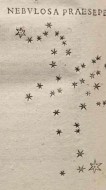Were stars artistically depicted with diffraction spikes before the invention of the Newtonian reflector? If so, why?

Octavo Corp. / Warnock Library
Stars were being drawn with points or spikes long before Isaac Newton announced his reflecting telescope in 1671. Just look at early works of art, flags, ancient coins, and the charts of the Pleiades and Praesepe star clusters made by Galileo in 1610. The similarity of certain flowers to rayed stars is apparent in their names, such as Aster Atticus (golden starwort). According to the Oxford English Dictionary, writers used the asterisk symbol (*) as early as the 1300s.
English amateur astronomer William Kitchiner wrote in 1825:
"When a Telescope is pointed at a Star, the least Defect in the figure, or adjustment of the metals in a Reflector, or of the object-glass in an Achromatic, immediately stares in your Eye, — Star not appearing round, but surrounded by false lights, radiating points, and little flitting luminous accompaniments. . . ."
So people thought of rays as an almost unavoidable aspect of a star's appearance due to imperfections in the eye or optics, long before astronomers began exploring the wave nature of light in the mid-19th century.
— Roger W. Sinnott
 0
0








Comments
You must be logged in to post a comment.